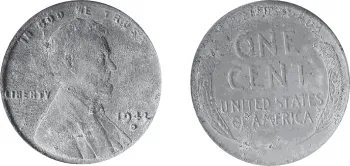THE DIRT ON COIN CURATION
By: Bryon Crowder
At the KNC meeting on 8-12-2025 a couple members asked me about the possibility of cleaning up 1943 steel cents. Since this was a 1-year only type coin, I had left it out of my presentation in July.

In 1943 the U.S. Mint changed the composition of the copper cent to zinc plated steel. We all know why. The low carbon steel core was plated with zinc to keep the steel from rusting. According to Wikipedia, the zinc plating was only 0.0005 inches thick (or thin!)
Does zinc rust? Why, yes! Yes, it does. While steel makes a reddish-brown rust, zinc makes a cloudy, whitish-gray rust. Zinc is subject to corrosion just like steel and iron, but at a much slower rate. Rust on zinc is caused by temperature, humidity, salinity, and airborne pollutants like sulphur (just like steel). Rust on zinc appears as zinc oxide or zinc hydroxide, and it forms a protective layer, or skin, that prevents the steel core from rusting. I’m sure most of us have seen
the effects of ‘zinc rot’ on our recent cents. Any recent cents that spend even a brief time on a salted parking lot in winter are soon unrecognizable.
The problem trying to curate 1943 cents is that the zinc surface isn’t just dirty, it has chemically changed. This change makes any cleaning just about impossible. However, it IS possible to strip off the old, unattractive zinc plating and put a new layer of zinc plating on the coin. These are then known as reprocessed cents, and in my opinion, they look just as good as the mint state
originals.
I recently looked online and found an eBay seller that had listed an uncertified 1943 Steel cent Unc. Gem BU for $28. Personally, I thought his grading and pricing were self-indulgent. However, reprocessed 1943 cents are available for just a few dollars from companies like Littleton coin, and elsewhere. At prices like this, I personally think that efforts to curate 1943 cents are a exercise in futility.
Credits to Google; Wikipedia; eBay